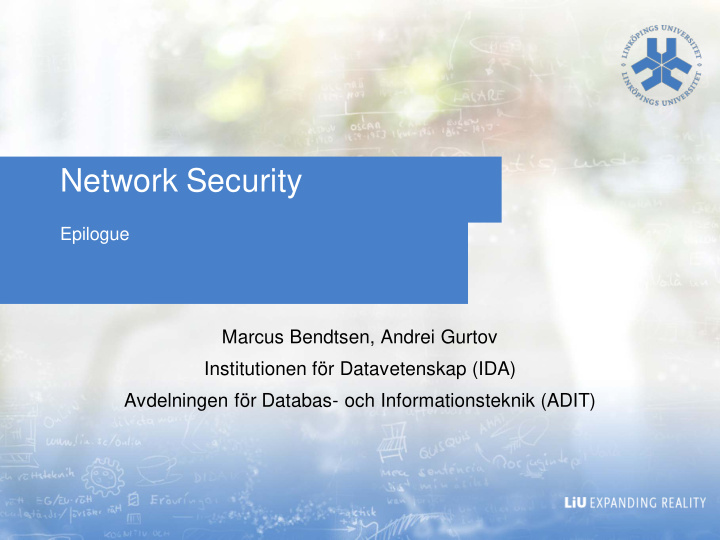



Network Security Epilogue Marcus Bendtsen, Andrei Gurtov Institutionen för Datavetenskap (IDA) Avdelningen för Databas- och Informationsteknik (ADIT)
The biggest threat to any security system… PEOPLE ARE PEOPLE 2
Social Engineering • Network security is not only about technology. • Social engineering plays on the ignorance, insecurities and fear of people. • The social engineer uses psychological techniques to trick others into doing things for them that they should not do. • They exploit personal knowledge about the subject, systems, organisation, etc. that they want to attack. • A good social engineer is a friend from the moment they start talking to you, they make you feel good … most of the time. When it does not work, they make you feel scared … 3
The social engineer could be using electronic surveillance to get keystrokes, could have planted a key-logger, or could Plays on surprise and fear, and can be simply be listening to what the user is very successful. typing (you can recover text fairly accurately from the sound of a keyboard). 4
Give up password for a cheap pen • Infosec 2003 organizers: • Interviewed travellers in London Waterloo station. • 75% gave up password when asked; 15% more after a follow-up question. • Common passwords: “password”, name, age, birthdate, etc. • 2/3 had told their passwords to a co-worker • 3/4 knew a co-workers password • 2/3 used the same password for everything 5
Usability • Underestimated part of security. • Problem is that security is extremely complex, and asking users and developers to know about security may be to big a task. • Just knowing about certificates seems to be a big problem, where users and developers accept certificates that are easily forged. • Security products on offer are most likely to complex, built by engineers that do not appreciate that end-users are not experts . 6
USB Threats • Half of people plug in USB drives they find in the parking lot • Researchers from Google, the University of Illinois Urbana- Champaign, and the University of Michigan, spread 297 USB sticks around the Urbana-Champaign campus • 48 percent of the drives were picked up and plugged into a computer, some within minutes of being dropped • Just 16% of users bothered to scan the drives with anti-virus software before loading the files; 68% said they took no precautions • 68% of the users said they were only accessing the drive in order to find its owner 7
SUMMARY OF NETWORK SECURITY 8
Network security • Network security starts with good network design: • Segmentation • Perimeter defence • Containment • The main focus of network design is to reduce exposure . • Do so by segmenting your networks and defend these perimeters with firewalls. • Firewalls are not an excuse for bad security elsewhere. • Wireless carries with it concerns that need to be taken seriously, even by those who decide on wired networks (rouge access points). 9
Network security • Securing communications is important to make sure that you have: • Confidentiality • Integrity • Authentication • Typical techniques include TLS/SSL and IPSec. • There are examples of protocols that are not designed with security awareness (ICMP, DNS, etc.) • Scanning is a useful for both good and bad, and requires very good understanding of network protocols. • IDS are critical, but require a lot of knowledge and consideration. • Humans pose the biggest threat against security, not all security has to do with technology. 10
Literature • Important for exam • Slides • D. Smith, “Improving Computer Security through Network Design”. • Matta Security Limited, “An introduction to Internet Attack and Penetration”. • Ptacek and Newsham, “Insertion Evasion and Denial of Service: Eluding Network Intrusion Detection”. • IPSec and SSL/TLS (There is an RFC and book chapters). Focus on learning what I presented on the slides. • Less important for exam • Security Flaws in 802.11 Data Link Protocols • DNSSEC • IDN whitepaper • Not important for exam • DNS Cache Poisoning – The Next Generation • Remote OS detection via TCP/IP stack fingerprinting 11
www.liu.se
Recommend
More recommend